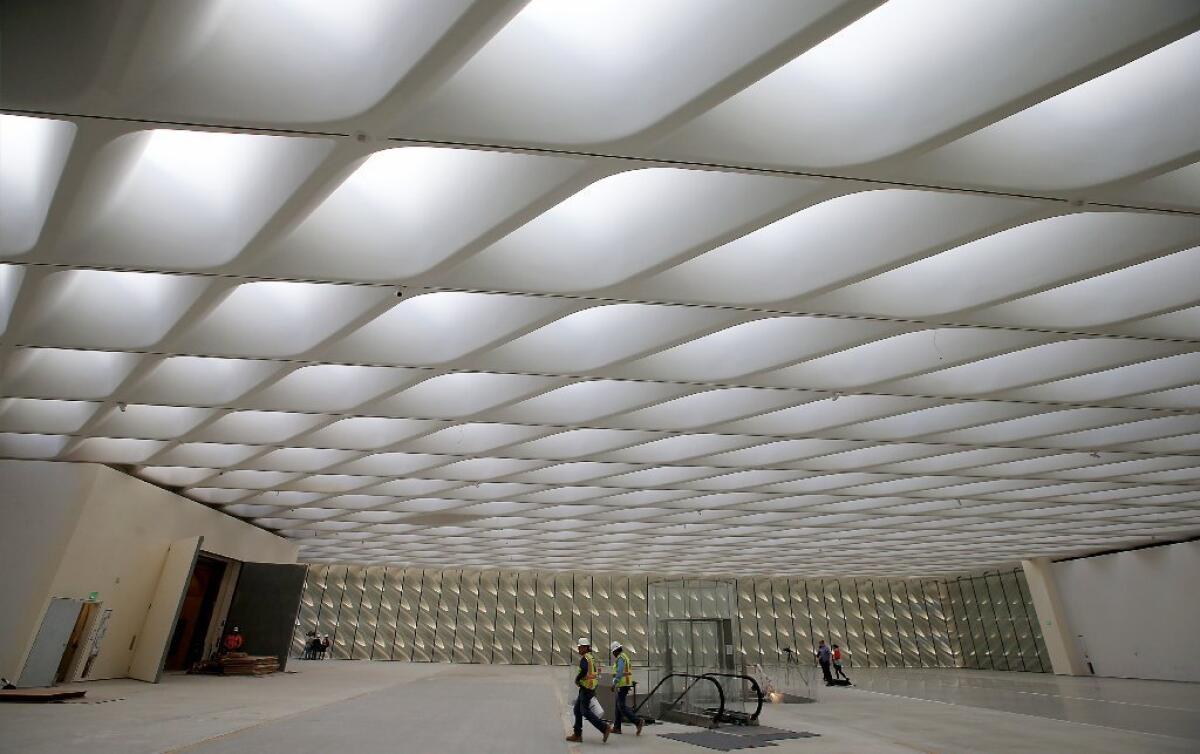Critic’s Notebook: An in-progress look at the Broad museum

- Share via
Architect Elizabeth Diller, dressed mostly in sober New York black, hard hat in hand, stood on the Grand Avenue sidewalk Friday morning in front of the Broad museum, which she designed with her New York firm, Diller Scofidio + Renfro, and is set to open Sept. 20.
Was she giving an architectural preview? Doing damage control? Trying to regain some influence over the narrative of the museum’s construction, which has been beset by delays, fabrication problems and legal wrangling?
The answer seemed to be some combination of the three. Diller, more jovial than defensive, was joined on the tour by Joanne Heyler, the director of the Broad museum, but it was the architect who said she had helped initiate the plan to open the nearly finished museum to some journalists Friday and then to ticketed members of the general public on Sunday.
MORE: Christopher Hawthorne’s early Broad museum tour -- the tweets
In certain ways the advance look, seven months before the Broad’s official debut, was reminiscent of a decision by Michael Govan, the director of the Los Angeles County Museum of Art, to give private tours of Renzo Piano’s Resnick Pavilion when that building was also nearly finished in 2010.
Govan installed a large piece by Walter de Maria, “The 2000 Sculpture,” inside the Resnick, allowing collectors, board members and critics a chance to see the building as a single, open gallery space before interior walls were installed.
The situation at the Broad is similar. Construction on the $140-million museum’s column-free top-floor gallery, covering 35,000 square feet (compared with 45,000 at the Resnick), is almost finished. Much of its concrete floor has been polished to a high sheen.
At the same time, the movable walls that will go up before the opening exhibition is installed, dividing the space (but stopping well short of the 23-foot ceiling), have yet to go up.
In other respects, the Broad case is a unique one, especially given the degree to which its construction has been plagued by delays (and with those delayed chronicled and picked apart by the media).
When the exterior scaffolding was removed from the building a few weeks ago, the reaction on social media and elsewhere was not good: People seemed let down that the facade they were now seeing in the flesh didn’t live up to the promise of earlier digital renderings.
The gap between image and reality was hardly shocking, though, given that the original design called for precast concrete panels and the final product uses a lighter, fiberglass-concrete composite instead.
For her part, Diller said the modified look of the facade, which is indeed more opaque than some early renderings suggested, has less to do with materials or engineering issues and more to do with an interest on the part of Heyler and billionaire philanthropist Eli Broad to make sure that no shafts of sunlight, at any time of year, are able to penetrate the interior and touch the art.
Inside the top-floor gallery, the building comes to life most directly at its northeast corner, where the openings in the panels are largest (and the amount of direct sunlight lowest) and some limited glimpses of Walt Disney Concert Hall, next door, are possible.
In the other corner of the building’s Grand Avenue facade, looking south toward the new Emerson apartment tower and the Museum of Contemporary Art, the openings are much more limited and the sense of connection to the outside world blunted.
After the interior walls and the art are installed, of course, the focus on those views to the outside will not be nearly as intense. There is also something to be said, of course, for a gallery where museumgoers can retreat from the city and concentrate only on looking at art.
On Friday morning, inside a strikingly cavernous empty room, under the repeating pattern of the overhead skylights, there was a strong draw to those Grand Avenue corners of the room — and a sense that the impulse to take in the views was one which the architecture itself seemed determined to frustrate.
The other overriding impression that the preview gives is that in the lobby, where the concern about sunlight is much less pressing, the gap between design and execution will be narrower.
The honeycombed facade of the building, which Diller calls the “veil” (shrouding the “vault” of the Broad Foundation archive in the center of the museum), is lifted on each corner, giving a far freer sense of visual connection to Grand Avenue and the rest of downtown Los Angeles than is possible upstairs.
The undulating lobby walls are pierced twice: by a narrow escalator that will take visitors directly up to the art on the top floor and by a staircase that will take them back down, giving a view into the archive and storage rooms along the way. Neither the escalator nor the stairway was open on Friday. Tours were using the freight elevator instead.
The lobby promises to be a strikingly unusual room, unlike any other in Los Angeles, essentially closed or windowless on two long walls and entirely open at the corners.
There is also an intriguing gap, creating a kind of portico along the front of the museum, between the lobby’s exterior glass wall and the facade. Heyler said it would make a shaded place for visitors to line up during the weeks following the museum’s September opening, when crowds are expected to be large.
She’s right about the level of interest. The $10 tickets for the Sunday open house, which will feature a sound installation by artist BJ Nilsen and a sound-and-light piece by Yann Novak, were snapped up almost immediately. Because of both the museum’s ambitious design and the problems that have dogged its construction, public curiosity about the Broad is exceptionally high.
Another chance to see the museum up close, though not to walk through the interior, will come in about six weeks, when the public plaza on its southwestern edge, designed in a collaboration between Diller’s firm and landscape architect Walter Hood, is expected to open.
Twitter: @HawthorneLAT
More to Read
The biggest entertainment stories
Get our big stories about Hollywood, film, television, music, arts, culture and more right in your inbox as soon as they publish.
You may occasionally receive promotional content from the Los Angeles Times.











